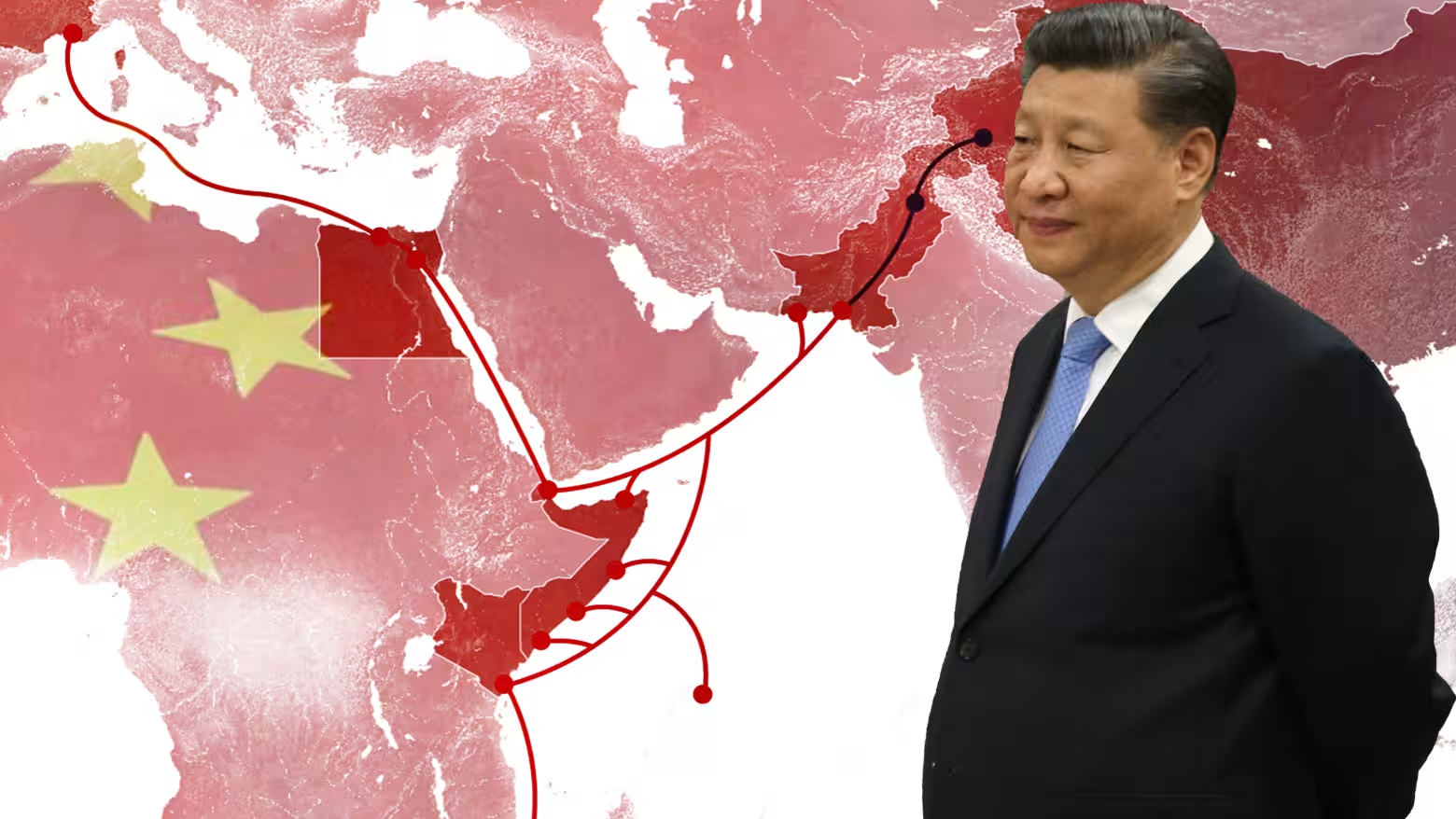This article is part of our collaboration with IE International Policy Review.

Image Credit: Getty
By Dominika Wiater. Edited by Grégoire Panzer.
China has found a new way to wield its power, not through traditional hard power but with fibre optics, AI systems and 5G technology. Through The Digital Silk Road (DRS), a key component of the Belt and Road Initiative (BRI), China has expanded its technological footprint throughout Asia, Africa and Europe. China is making modern technology accessible to developing countries by offering affordable digital infrastructure. Yet, while the DSR offers innovation, its growing role also raises an important question: Are these nations gaining technological independence, or becoming entangled in the Chinese digital web?
For many developing countries, partnering with China through initiatives like Huawei’s Digital Silk Road means gaining access to essential digital infrastructure—such as data centres and telecommunications systems—while also benefiting from projects like those in Kenya, where Huawei has enhanced Information and Capacity Technology capacity and provided local training programs that empower engineers to independently manage and maintain these systems. As these nations take advantage of the digital futures based on Chinese systems, they also find themselves increasingly dependent on Beijing for critical technology.
A Mutually Beneficial Model
A key factor behind the DSR’s reach is the relationship between the Chinese state and its tech giants, including Huawei, Tencent and Alibaba. In what has been called a “state-capital nexus”, these companies benefit from state backing as they expand into new markets, while China gains influence as its firms establish critical digital infrastructure globally. Unlike the Western approach, where corporations typically operate independently from government agendas and often influence politics in their own favour, China’s state capitalism centralises decision-making and aligns corporate strategies to national objectives. This alignment gives Chinese firms the ability to offer affordable infrastructure and financing options to developing nations, embedding Chinese technology into global digital ecosystems and amplifying Beijing’s influence through these partnerships.
With this in mind, Chinese companies are able to offer attractive rates and financing for developing nations, giving them the competitive edge over Western firms. Developing countries benefit from affordable, modern infrastructure, but these deep rooted economic ties also position China as an enduring partner in their digital future. Some critics argue that this dependency on Chinese technology could make it difficult for these countries to explore alternative suppliers and infrastructure options, especially as their reliance on China’s systems increases over time.
Building Innovation or Creating Dependency?
The attractiveness of China’s DSR is clear. For countries with limited digital infrastructure opportunities, Chinese technology offers a fast track to modernisation and potential economic development. China’s AI-driven systems, 5G networks, and telecom technologies are generally cheaper and have funding possibilities that Western corporations can’t deliver. However, this financial accessibility comes with its own risk.
Many DSR projects rely on loans from Chinese banks, creating potential debt burdens for partner nations. These arrangements have drawn comparison to the “debt diplomacy” criticism of the physical Belt and Road initiative, where some countries found themselves unable to repay loans, leading to long-term economic dependency. Such financial entanglements may limit a nation’s ability to negotiate with other partners or pursue independent technology policies in the future. Is this debt diplomacy strategy an exercise of soft power, or does it veer into coercion?
Data is a growing concern. Through DSR projects, large amounts of digital information flow through systems developed by Chinese companies, stored in Chinese-controlled data centres. While there is no direct evidence that China is aiming to leverage this data for influence, the concentration of control over digital networks and data flows, has led to questions about the long-term digital sovereignty for DSR partner countries. Chinese businesses and governments have access to enormous local data pools through the DSR. Beijing’s influence could grow as partner nations rely more on its infrastructure, though this depends on how effectively local governments regulate cybersecurity. Historical cases like the Facebook-Cambridge Analytica scandal remind us that any provider of advanced technology can misuse its position, raising concerns about potential data vulnerabilities under the DSR’s model. In addition, cybersecurity risks cannot be ignored. For example, Huawei-built systems in Papua New Guinea were found to have inadequate encryption, leaving sensitive data vulnerable to breaches. Although these countries stand to gain much from modernisation, their ability to create autonomous digital ecosystems may be constrained if they continue to depend on Chinese technology.
Who sets the rules?
While the DSR promises modernization, the underlying question remains: who controls the flow of information and sets the rules of engagement in this digital order? China’s Digital Silk Road is more than just a network of high-tech facilities, it reflects a new vision for digital governance. In contrast, to Western-led tech partnerships that often come with regulatory requirements concerning data privacy and security, China’s approach is “hands off” on issues of domestic governance. This is very attractive to leaders in countries looking for development partnerships without diplomatic or political pressures that usually accompany Western tech companies. China’s principle of non-interference aligns well with leaders who seek to avoid external scrutiny.
New standards brought about by China’s digital infrastructure’s growth might influence these nations’ digital governance. The digital governance of countries may become more similar to China’s approach of centralised data control if they embrace methods and standards advocated by Chinese enterprises. Despite its subtlety, this change raises the possibility that the Digital Silk Road might affect local standards around data sovereignty and information flow, even in the absence of direct interference. There has been no clear indication of China exerting political influence, therefore the change in governance patterns is more of a slow motion train wreck than an attempt at overt policy intervention.
As countries adopt systems shaped by China’s DSR, they may unwittingly align their digital governance with Beijing’s standards. This soft power dynamic not only reflects China’s technological leadership but also positions it as a model of centralised governance. While there has been no clear evidence of China exerting political influence over partner nations through the Digital Silk Road, its increase in international presence, particularly in setting global technology standards, reflects a strategic effort to enhance its geopolitical leverage and reinforce its domestic priorities. Moreover, examples such as China’s pressures on Taiwan, Nepal and Kashmir highlight how it leverages its growing geopolitical influence to reinforce its domestic policy objectives. In this sense, the DSR could be seen as an extension of China’s broader strategy to fortify its regional dominance while deterring external actors from meddling in sensitive areas.
China’s Digital Silk Road could be viewed as a double-edged sword in the realm of soft power. On one hand, it provides essential digital infrastructure to countries that need it most, an action that reflects Joseph Nye’s idea of shaping preferences through attraction rather than force. By making AI, 5G and data centres accessible, China is building goodwill presenting itself as a partner in growth and connectivity. This strategic position allows China to foster positive relationships while presenting an appealing model of digital modernisation without the typical governance restrictions that accompany the West.
The question remains: is this soft power, or does it verge on digital coercion? As developing countries become more intertwined with Chinese technology, their options for alternative suppliers narrow and the dependence on Chinese systems deepens. Critics argue that the allure of innovation may come at the cost of digital sovereignty, as these nations heavily rely on Chinese tech giants for maintenance, upgrades and security over time.
While China may be redefining soft power by embedding itself in the technological future of its partners, true soft power relies on voluntary appeal, not dependency. If these partnerships tip the balance toward reliance, then China’s Digital Silk Road may ultimately hinder rather than increase its positive global image.
Other posts that may interest you:
Discover more from The Sundial Press
Subscribe to get the latest posts sent to your email.





